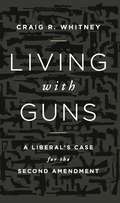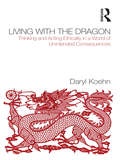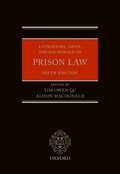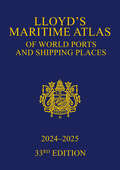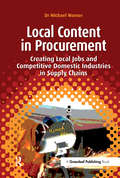- Table View
- List View
Living with Guns: A Liberal's Case for the Second Amendment
by Craig WhitneyNewtown. Columbine. Virginia Tech. Tucson. Aurora. Gun violence on a massive scale has become a plague in our society, yet politicians seem more afraid of having a serious conversation about guns than they are of the next horrific shooting. Any attempt to change the status quo, whether to strengthen gun regulations or weaken them, is sure to degenerate into a hysteria that changes nothing. Our attitudes toward guns are utterly polarized, leaving basic questions unasked: How can we reconcile the individual right to own and use firearms with the right to be safe from gun violence? Is keeping guns out of the hands of as many law-abiding Americans as possible really the best way to keep them out of the hands of criminals? And do 30,000 of us really have to die by gunfire every year as the price of a freedom protected by the Constitution?In Living with Guns, Craig R. Whitney, former foreign correspondent and editor at the New York Times, seeks out answers. He re-examines why the right to bear arms was enshrined in the Bill of Rights, and how it came to be misunderstood. He looks to colonial times, surveying the degree to which guns were a part of everyday life. Finally, blending history and reportage, Whitney explores how twentieth-century turmoil and culture war led to today's climate of activism, partisanship, and stalemate, in a nation that contains an estimated 300 million guns--and probably at least 60 million gun owners.In the end, Whitney proposes a new way forward through our gun rights stalemate, showing how we can live with guns--and why, with so many of them around, we have no other choice.
Living With Hacktivism: From Conflict to Symbiosis (Palgrave Studies in Cybercrime and Cybersecurity)
by Vasileios KaragiannopoulosThis book focuses on the phenomenon of hacktivism and how it has been dealt with up to now in the United States and the United Kingdom. After discussing the birth of the phenomenon and the various relevant groups, from Electronic Disturbance Theater to Anonymous, their philosophies and tactics, this timely and original work attempts to identify the positive and negative aspects hacktivism through an analysis of free speech and civil disobedience theory. Engaging in this process clarifies the dual nature of hacktivism, highlighting its potential for positive contributions to contemporary politics, whilst also demonstrating the risks and harms flowing from its controversial and legally ambiguous nature. Based on this hybrid nature of hacktivism, Karagiannopoulos proceeds to offer a critique of the current responses towards such practices and their potential for preserving the positive elements, whilst mitigating the risks and harms involved in such political practices. Finally, the study focuses on identifying an alternative, symbiotic rationale for responding to hacktivism, based on a cluster of micro-interventions moving away from the conflict-based criminal justice model and the potentially unjust and inefficacious results it entails.
Living With Hacktivism: From Conflict to Symbiosis (Palgrave Studies in Cybercrime and Cybersecurity)
by Vasileios KaragiannopoulosThis book focuses on the phenomenon of hacktivism and how it has been dealt with up to now in the United States and the United Kingdom. After discussing the birth of the phenomenon and the various relevant groups, from Electronic Disturbance Theater to Anonymous, their philosophies and tactics, this timely and original work attempts to identify the positive and negative aspects hacktivism through an analysis of free speech and civil disobedience theory. Engaging in this process clarifies the dual nature of hacktivism, highlighting its potential for positive contributions to contemporary politics, whilst also demonstrating the risks and harms flowing from its controversial and legally ambiguous nature. Based on this hybrid nature of hacktivism, Karagiannopoulos proceeds to offer a critique of the current responses towards such practices and their potential for preserving the positive elements, whilst mitigating the risks and harms involved in such political practices. Finally, the study focuses on identifying an alternative, symbiotic rationale for responding to hacktivism, based on a cluster of micro-interventions moving away from the conflict-based criminal justice model and the potentially unjust and inefficacious results it entails.
Living with Robots
by Paul DumouchelLiving with Robots recounts a foundational shift in robotics, from artificial intelligence to artificial empathy, and foreshadows an inflection point in human evolution. As robots engage with people in socially meaningful ways, social robotics probes the nature of the human emotions that social robots are designed to emulate.
Living with Robots
by Paul DumouchelLiving with Robots recounts a foundational shift in robotics, from artificial intelligence to artificial empathy, and foreshadows an inflection point in human evolution. As robots engage with people in socially meaningful ways, social robotics probes the nature of the human emotions that social robots are designed to emulate.
Living with the Dead: On Death, the Dead, and Immortality (Routledge Studies in Contemporary Philosophy)
by J. Jeremy WisnewskiThis book explores the moral place of the dead in our lives and in our afterlives. It argues that our lives are saturated by the past intentions and values of the dead, and that we offer the dead a form of modest immortality by fulfilling our obligations to remember them. In the first part of the book, the author examines the scope and limits of our obligations to the dead. Our obligations to respect the wishes of the dead are more substantial than commonly acknowledged, but they can be overridden in a range of cases when they conflict with the vital interests of the living, such as in organ donation and wealth inheritance. By contrast, the author contends that the obligation to remember, at least collectively, cannot be completely overridden. In the second part of the book, the author argues that tradition offers the dead a form of modest immortality—the dead live on insofar as we enact those intentional states with which they most identified. He draws on the Confucian view of ritual to argue that ritual absorption "reincarnates" the dead in the actions of the living. Finally, the author defends a Jamesian account of a pluralistic self that is consistent with the view that we have obligations to the individual dead and that the selves of the dead are pragmatic constructions. Living with the Dead will appeal to scholars and students interested in the philosophy of death, ethics, and cross-cultural philosophy.
Living with the Dead: On Death, the Dead, and Immortality (Routledge Studies in Contemporary Philosophy)
by J. Jeremy WisnewskiThis book explores the moral place of the dead in our lives and in our afterlives. It argues that our lives are saturated by the past intentions and values of the dead, and that we offer the dead a form of modest immortality by fulfilling our obligations to remember them. In the first part of the book, the author examines the scope and limits of our obligations to the dead. Our obligations to respect the wishes of the dead are more substantial than commonly acknowledged, but they can be overridden in a range of cases when they conflict with the vital interests of the living, such as in organ donation and wealth inheritance. By contrast, the author contends that the obligation to remember, at least collectively, cannot be completely overridden. In the second part of the book, the author argues that tradition offers the dead a form of modest immortality—the dead live on insofar as we enact those intentional states with which they most identified. He draws on the Confucian view of ritual to argue that ritual absorption "reincarnates" the dead in the actions of the living. Finally, the author defends a Jamesian account of a pluralistic self that is consistent with the view that we have obligations to the individual dead and that the selves of the dead are pragmatic constructions. Living with the Dead will appeal to scholars and students interested in the philosophy of death, ethics, and cross-cultural philosophy.
Living With the Dragon: Acting Ethically in a World of Unintended Consequences
by Daryl KoehnThe book consists of a short introduction to the significance of unintended consequences and four chapters. The first chapter develops a typology of unintended consequences and distinguishes them from historical contingencies. The second chapter analyzes three types of causes of such consequences: worldly, practical and psychological causes. The third explores the significant problems these consequences pose for standard moral theories. The fourth and final chapter examines how we might begin both to think about and cope with unintended consequences in an ethically good way.
Living With the Dragon: Acting Ethically in a World of Unintended Consequences
by Daryl KoehnThe book consists of a short introduction to the significance of unintended consequences and four chapters. The first chapter develops a typology of unintended consequences and distinguishes them from historical contingencies. The second chapter analyzes three types of causes of such consequences: worldly, practical and psychological causes. The third explores the significant problems these consequences pose for standard moral theories. The fourth and final chapter examines how we might begin both to think about and cope with unintended consequences in an ethically good way.
Livingstone, Owen, and Macdonald on Prison Law
by Tim Owen QC and Alison MacdonaldPrison Law is the leading text in its field. It offers comprehensive coverage of the substantive law, the Prison Rules, and the remedies available to prisoners, including complaints procedures, civil claims, judicial review, and claims under the Human Rights Act. Both domestic and international avenues of redress are explained in detail. The book covers all aspects of prison life, from categorization and allocation to living conditions, access to the outside world, transfer and repatriation, discipline, and the procedures governing the release of fixed term prisoners and those serving life sentences. In recent years, restricted access to legal aid and the ongoing threat to the Human Rights Act have made it increasingly difficult for prisoners to exercise their rights. It would now be impossible for prison law to play the same major role in developing constitutional and public law as it has for the past 30 years. As a result, prison law practitioners are having to adapt and evolve their approach to cope with new challenges. The new edition has been completely revised and updated to take account of relevant decisions under the Human Rights Act and at the European Court of Human Rights, including important decisions on IPP sentences, ministerial involvement in prison release, conditions of detention, and their policy ramifications in the UK. The changes to the life sentence regime and the prison disciplinary system, implemented since publication of the previous edition, have been fully addressed. It also covers the Equality Act and its application in the prison context. Further, it includes a new introduction summarizing the development of prison law over the 20 years since the first edition, and its importance in the wider context of public law principles especially the expansion of jurisdiction (St Germain, Leech and Hague), fairness (Duggan, Doody), the principle of legality (Raymond v Honey, Leech No 2, Pierson, Simms and O'Brien) and HRA review (Daly and subsequent HRA decisions). Critical analysis is combined with practical guidance to make Prison Law immensely useful to practitioners, academics, and anyone with a professional interest in crime and punishment.
Livingstone, Owen, and Macdonald on Prison Law
Prison Law is the leading text in its field. It offers comprehensive coverage of the substantive law, the Prison Rules, and the remedies available to prisoners, including complaints procedures, civil claims, judicial review, and claims under the Human Rights Act. Both domestic and international avenues of redress are explained in detail. The book covers all aspects of prison life, from categorization and allocation to living conditions, access to the outside world, transfer and repatriation, discipline, and the procedures governing the release of fixed term prisoners and those serving life sentences. In recent years, restricted access to legal aid and the ongoing threat to the Human Rights Act have made it increasingly difficult for prisoners to exercise their rights. It would now be impossible for prison law to play the same major role in developing constitutional and public law as it has for the past 30 years. As a result, prison law practitioners are having to adapt and evolve their approach to cope with new challenges. The new edition has been completely revised and updated to take account of relevant decisions under the Human Rights Act and at the European Court of Human Rights, including important decisions on IPP sentences, ministerial involvement in prison release, conditions of detention, and their policy ramifications in the UK. The changes to the life sentence regime and the prison disciplinary system, implemented since publication of the previous edition, have been fully addressed. It also covers the Equality Act and its application in the prison context. Further, it includes a new introduction summarizing the development of prison law over the 20 years since the first edition, and its importance in the wider context of public law principles especially the expansion of jurisdiction (St Germain, Leech and Hague), fairness (Duggan, Doody), the principle of legality (Raymond v Honey, Leech No 2, Pierson, Simms and O'Brien) and HRA review (Daly and subsequent HRA decisions). Critical analysis is combined with practical guidance to make Prison Law immensely useful to practitioners, academics, and anyone with a professional interest in crime and punishment.
Lizensur: Was darf fiktionale Literatur? (Literatur und Recht #7)
by Eric Achermann Daniel Arjomand-Zoike Nursan CelikÖffentliche Kontroversen um Literatur werden primär unter ethischen und juristischen Prämissen diskutiert und münden oftmals in Debatten, die den Zensurvorwurf perpetuieren. Darüber geraten die Lizenzen, auf die sich Literatur in Theorie und Praxis gern beruft, schnell in Vergessenheit. Der interdisziplinär angelegte Band widmet sich den Sondererlaubnissen fiktionaler Literatur, die unter dem Schlagwort „Lizensur“ präsentiert, kritisch analysiert und historisch kontextualisiert werden. Auf diese Weise wird das spannungsreiche Verhältnis zwischen Fiktion und Lizenz in einen literatursysteminternen, geschichtlichen sowie rechtlichen Zusammenhang gestellt.
Lloyd's: Law And Practice (Lloyd's Insurance Law Library)
by Julian BurlingThe unique features of the Lloyd’s Corporation and Market and their governing rules are complex and are often difficult to navigate even for the most seasoned practitioner. This book provides the reader with a definitive and detailed guide, and is essential for any practitioner dealing with Lloyd’s Insurance. After a brief historical account, the book provides a thorough legal description and analysis of Lloyd’s, which includes topics ranging from the constitution and membership requirements of Lloyd’s, UK and overseas regulation, the processes for placing and underwriting business and handling claims, chain of security, enforcement and disciplinary matters, compensation and the reconstruction and the renewal of the Lloyd’s market between 1990 and 1996. The book will be an invaluable reference tool for insurance practitioners and professionals dealing with Lloyd’s. Julian Burling is a barrister at Serle Court, and has been involved in advising on and implementing nearly all significant legal developments at Lloyd’s in the last 25 years.
Lloyd's: Law and Practice (Lloyd's Insurance Law Library)
by Julian BurlingThe unique features of the Lloyd’s Corporation and Market and their governing rules are complex and are often difficult to navigate even for the most seasoned practitioner. This book provides the reader with a definitive and detailed guide, and is essential for any practitioner dealing with Lloyd’s Insurance. After a brief historical account, the book provides a thorough legal description and analysis of Lloyd’s, which includes topics ranging from the constitution and membership requirements of Lloyd’s, UK and overseas regulation, the processes for placing and underwriting business and handling claims, chain of security, enforcement and disciplinary matters, compensation and the reconstruction and the renewal of the Lloyd’s market between 1990 and 1996. The book will be an invaluable reference tool for insurance practitioners and professionals dealing with Lloyd’s. Julian Burling is a barrister at Serle Court, and has been involved in advising on and implementing nearly all significant legal developments at Lloyd’s in the last 25 years.
Lloyd's Maritime Atlas of World Ports and Shipping Places 2022-2023
by Paul AldworthPublished since 1951, Lloyd’s Maritime Atlas is the oldest and most respected atlas in the shipping industry. A comprehensive reference for locating the world’s busiest ports and shipping places, this new edition has been fully updated and enhanced with brand new maps and features to alleviate the demands on today’s busy shipping professional. In the 2022-2023 edition: Fully up to date with the latest port names and locations Up-to-date MARPOL regulations (2021), including SECA areas and worldwide PSSAs Double page spread revealing piracy hotspots and detailed analysis of routes to avoid as well as a symbol indicating incidence of piracy on the main maps World map of vaccinations required to protect against major global diseases Up-to-the-minute Marine Distance Tables and fleet statistics In addition, Lloyd’s Maritime Atlas continues to provide: Precise latitude and longitude co-ordinated of more than 8,000 ports and shipping places from around the world Over 70 full-colour world, ocean and regional maps At-a-glance weather hazards at sea and international load line zone maps Expansive double-page world distance table plus 33 detailed regional tables to help you plan your route Unique geographical and alphabetical indexing system to help you quickly and easily find your location All major canal and river systems, plus main road, rail and airport connections to cater for multi-modal journeys This book continues to be the premier reference guide for shipping professionals worldwide. We are always looking for ways in which to improve our products and services and we welcome any comments and suggestions that you may have concerning this Atlas or any of our other publications using the contact details on our website www.routledge.com.
Lloyd's Maritime Atlas of World Ports and Shipping Places 2022-2023
by Informa Uk Informa Uk LtdPublished since 1951, Lloyd’s Maritime Atlas is the oldest and most respected atlas in the shipping industry. A comprehensive reference for locating the world’s busiest ports and shipping places, this new edition has been fully updated and enhanced with brand new maps and features to alleviate the demands on today’s busy shipping professional. In the 2022-2023 edition: Fully up to date with the latest port names and locations Up-to-date MARPOL regulations (2021), including SECA areas and worldwide PSSAs Double page spread revealing piracy hotspots and detailed analysis of routes to avoid as well as a symbol indicating incidence of piracy on the main maps World map of vaccinations required to protect against major global diseases Up-to-the-minute Marine Distance Tables and fleet statistics In addition, Lloyd’s Maritime Atlas continues to provide: Precise latitude and longitude co-ordinated of more than 8,000 ports and shipping places from around the world Over 70 full-colour world, ocean and regional maps At-a-glance weather hazards at sea and international load line zone maps Expansive double-page world distance table plus 33 detailed regional tables to help you plan your route Unique geographical and alphabetical indexing system to help you quickly and easily find your location All major canal and river systems, plus main road, rail and airport connections to cater for multi-modal journeys This book continues to be the premier reference guide for shipping professionals worldwide. We are always looking for ways in which to improve our products and services and we welcome any comments and suggestions that you may have concerning this Atlas or any of our other publications using the contact details on our website www.routledge.com.
Lloyd's Maritime Atlas of World Ports and Shipping Places 2024-2025
by Lloyd’sWelcome to the 33rd edition of Lloyd’s Maritime Atlas. Published since 1951, Lloyd’s Maritime Atlas is the oldest and most respected atlas in the shipping industry. A comprehensive reference for locating the world’s busiest ports and shipping places, this new edition has been fully updated and enhanced with revised maps and new features to alleviate the demands on today’s busy shipping professional. In the 2024–2025 edition you will find: The maps and indexes have been updated with the latest port names and locations, and expanded with almost 200 new ports integrated The addition of more than 400 new anchorages, 45 marine terminals, 22 offshore facilities, and 85 oil and gas fields The latest data on piracy incidents applied to a global overview with summaries by region, vessel type and dwt, plus every map featuring three grades of incident symbols to highlight the severity of different hotspots The MARPOL map has been separated from PSSA and SECA for increased clarity, with new Mediterranean Sea areas for SECA and PSSA integrated An updated world map of vaccinations required to protect against major global diseases The very latest Marine Distance Tables and fleet statistics In addition, Lloyd’s Maritime Atlas continues to provide: Precise latitude and longitude co-ordination of more than 9,000 ports and shipping places around the world More than 70 full-colour world, ocean, and regional maps A global overview of international load line zones An expansive double-page world distance table plus 33 detailed regional tables to help you plan your route A unique and extensive geographical and alphabetical indexing system to help readers quickly and easily find a location All major canal and river systems, plus main road, rail, and airport connections to cater for multi-modal journeys This book continues to be the premier reference guide for shipping professionals worldwide. We are always looking for ways in which to improve our products and services and we welcome any comments and suggestions that you may have concerning this Atlas or any of our other publications using the contact details on our website www.routledge.com.
Lloyd's Maritime Atlas of World Ports and Shipping Places 2024-2025
Welcome to the 33rd edition of Lloyd’s Maritime Atlas. Published since 1951, Lloyd’s Maritime Atlas is the oldest and most respected atlas in the shipping industry. A comprehensive reference for locating the world’s busiest ports and shipping places, this new edition has been fully updated and enhanced with revised maps and new features to alleviate the demands on today’s busy shipping professional. In the 2024–2025 edition you will find: The maps and indexes have been updated with the latest port names and locations, and expanded with almost 200 new ports integrated The addition of more than 400 new anchorages, 45 marine terminals, 22 offshore facilities, and 85 oil and gas fields The latest data on piracy incidents applied to a global overview with summaries by region, vessel type and dwt, plus every map featuring three grades of incident symbols to highlight the severity of different hotspots The MARPOL map has been separated from PSSA and SECA for increased clarity, with new Mediterranean Sea areas for SECA and PSSA integrated An updated world map of vaccinations required to protect against major global diseases The very latest Marine Distance Tables and fleet statistics In addition, Lloyd’s Maritime Atlas continues to provide: Precise latitude and longitude co-ordination of more than 9,000 ports and shipping places around the world More than 70 full-colour world, ocean, and regional maps A global overview of international load line zones An expansive double-page world distance table plus 33 detailed regional tables to help you plan your route A unique and extensive geographical and alphabetical indexing system to help readers quickly and easily find a location All major canal and river systems, plus main road, rail, and airport connections to cater for multi-modal journeys This book continues to be the premier reference guide for shipping professionals worldwide. We are always looking for ways in which to improve our products and services and we welcome any comments and suggestions that you may have concerning this Atlas or any of our other publications using the contact details on our website www.routledge.com.
Lloyd's MIU Handbook of Maritime Security
by Rupert Herbert-Burns Peter Lehr Sam BatemanManaging the ever-changing nature and cross-disciplinary challenges of the maritime sector demands a complete understanding of the special characteristics of the maritime space. The complexity of the operations of ships, ports, shipping companies, and naval and coast guard maritime security operations as well as the economic significance and the in
Lobbying for Good: How Business Advocacy Can Accelerate the Delivery of a Sustainable Economy
by Paul Monaghan Philip MonaghanThe business case for sustainability or corporate responsibility will never be strong enough to support an isolated business in its competition against the unscrupulous. The progressive vanguard reaches a point where it can advance no further without rendering itself uncompetitive. That is, unless advocacy and public policy intervention change the rules and shift the bar for the allowable lowest common denominator. With the base reset, so is the bar of aspiration. New rules enable new behaviours, with players competing on a fairer, more sustainable footing. This ground-breaking book, Lobbying for Good, describes how far-sighted businesses are rebooting the game, throwing off cultural inhibitions and sticking their head above the parapet to advocate progressive legislative change. The authors describe a strategic opportunity to get on board the next wave of CSR – the most radical and impactful yet – and explain how finely-tuned and well-delivered lobbying for good can be an extremely cost-effective brand-enhancement tool. Against a backdrop of general mistrust in business lobbying, learn how leaders are making it work and lobbying for good.
Lobbying for Good: How Business Advocacy Can Accelerate the Delivery of a Sustainable Economy (Doshorts Ser.)
by Paul Monaghan Philip MonaghanThe business case for sustainability or corporate responsibility will never be strong enough to support an isolated business in its competition against the unscrupulous. The progressive vanguard reaches a point where it can advance no further without rendering itself uncompetitive. That is, unless advocacy and public policy intervention change the rules and shift the bar for the allowable lowest common denominator. With the base reset, so is the bar of aspiration. New rules enable new behaviours, with players competing on a fairer, more sustainable footing. This ground-breaking book, Lobbying for Good, describes how far-sighted businesses are rebooting the game, throwing off cultural inhibitions and sticking their head above the parapet to advocate progressive legislative change. The authors describe a strategic opportunity to get on board the next wave of CSR – the most radical and impactful yet – and explain how finely-tuned and well-delivered lobbying for good can be an extremely cost-effective brand-enhancement tool. Against a backdrop of general mistrust in business lobbying, learn how leaders are making it work and lobbying for good.
Lobbyists: Untold Story of Oil Gas and Energy Sector
by Rajeev JayaswalIn early 2000, India caught attention of global petroleum giants after it announced world's biggest gas discovery. In 2004, it announced another world-class oil discovery in Rajasthan. These developments raised India's hope that the world's fourth largest oil importer would be able to significantly reduce over-dependence on the Gulf and other oil producing countries.But, subsequent developments belied the hope. Soon India's oil and gas dream turned out to be a nightmare. Controversies gripped domestic oil and gas industry. Greed for gas resulted into a major corporate war. It involved politicians, media and some members of the civic society. The Congress-led Manmohan Singh government was accused of encouraging crony capitalism. Allegations of corruption triggered probes by auditors and investigative agencies. Bureaucrats stopped taking decisions. The government suffered acute policy paralysis. Exploration and production of oil and gas suffered. In less than one decade India's import dependence jumped. India left Japan behind to become world's third largest oil importer after the United States and China. This would have comforted oil exporting countries. India would continue to remain their most dependable market as it imported more than 80% crude oil it processes. The future $150-160 oil market was secure thanks to intense internal strife over oil and gas matters. But, a question remained unanswered. Was the decade-long turbulence sponsored by some lobbyists having share in this import pie? This book is an attempt to examine it.Was it a mere coincidence that India's energy security engagements with neighbours, particularly with Iran lost vigour after the first Oil Minister Mani Shankar Iyar was removed? Was the Civil Nuclear Deal an American sugar-coated pill that contained the Nuclear Non-proliferation Treaty (NPT)? The book highlights certain factual developments at that time that would throw some light on these questions. This book is also iconoclastic. It attempts to change the popular perception created by certain groups or individuals around the oil and gas sector controversies. It explains how certain political and corporate elements took advantage of the confusion to pursue their self interests? What was perceived as black was in fact, not so dark and what was felt completely white, had shades of gray. So far people had been shown only 180-degree of the oil and gas controversies. This book brings up the other side of the picture, which was hitherto hidden. This is an attempt to complete the circle so that reader can form a 360-degree picture.
The Local: The suspenseful Southern legal drama for fans of Michael Connelly and Steve Cavanagh
by Joey HartstoneA suspenseful legal drama packed with Southern atmosphere for fans of The Good Wife and Michael Connelly'Razor sharp, reminiscent of the best of Grisham' Kia AbdullahBIG BUSINESSJames Euchre lives an easy life as a local attorney in a small Texan town, making plenty of money from patent infringement cases.BAD BLOODBut when his mentor is killed and one of his clients is arrested for murder, James is forced to take on his first criminal case - defending the man who allegedly killed his friend.BETRAYALThe deeper James goes into the case, the more he fears that he'll fail to save an innocent client's life - or worse, wind up freeing a guilty man...
The Local Budget as a Complex System (Palgrave Studies in Public Debt, Spending, and Revenue)
by Jeffrey ChapmanThis book examines budgeting by analyzing the local government budget as a complex system, thus adding a new dimension to traditional budget textbooks. It is designed to complement existing texts—not replace—by putting the budget in a complex system, general equilibrium framework. A complex systems framework adds to conventional budget analysis in at least four ways: It looks at the budget as the result of many variables that are outside the finance department’s purview; it understands that there are multiple interdependences among these variables; it suggests analysis of non-obvious relationships among actions in the budget process in order to optimize results; and it argues that the actors in the process must understand that their budgetary behaviors have indirect and far-reaching implications that go beyond the budget document. This book also uses concepts seldom discussed in the budgetary literature—that of governance, including concepts of the facilitative state, with adjustments for exogenous shocks; the forms of decision making; and the political climate of the jurisdiction. This framework notes methods of success of firms in the private sector that operate in environments of rapid technological change. While becoming a popular theoretical framework for how private sector firms change, dynamic capability analysis has received little attention in the public management field. This book utilizes DC since public sector organizations also face rapidly changing environments. Lastly, the book discusses the potential relationship between the local budget and local community welfare maximization.
Local Content in Procurement: Creating Local Jobs and Competitive Domestic Industries in Supply Chains
by Michael WarnerLocal Content in Procurement is the first book of its kind. Recognizing the substantial economic and social value brought to host countries and local communities through the procurement practices of large private and public companies, this book by Dr Michael Warner – Director of the consultancy firm Local Content Solutions and former architect of the Local Content standards for BG Group – provides a first-hand account of the Local Content regulations, strategies and procurement processes needed to realise these social benefits. Acknowledging that the employment and industrial benefits of large-scale procurement have been sorely overlooked, this book is both a how-to manual and a thoughtful insight into the challenge of creating sustainable jobs and competitive national industries through expenditure on bought-in goods and services. With literally trillions of dollars of goods and services being procured over the next ten years in exploring and developing for oil, gas and mineral resources across the globe, the book focuses on these sectors, yet also has wide application to the utilities, construction, infrastructure, manufacturing and defence sectors. Local Content in Procurement has been written for those working for the procurement, strategy and social responsibility departments of major private and public companies and international suppliers, for industrial and economic policy-makers and regulators of local content, and for all those involved in the management of procurement expenditure to develop national and local industries.
